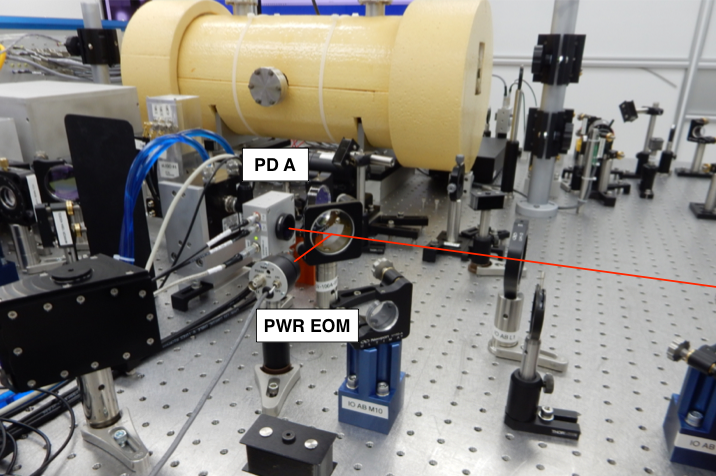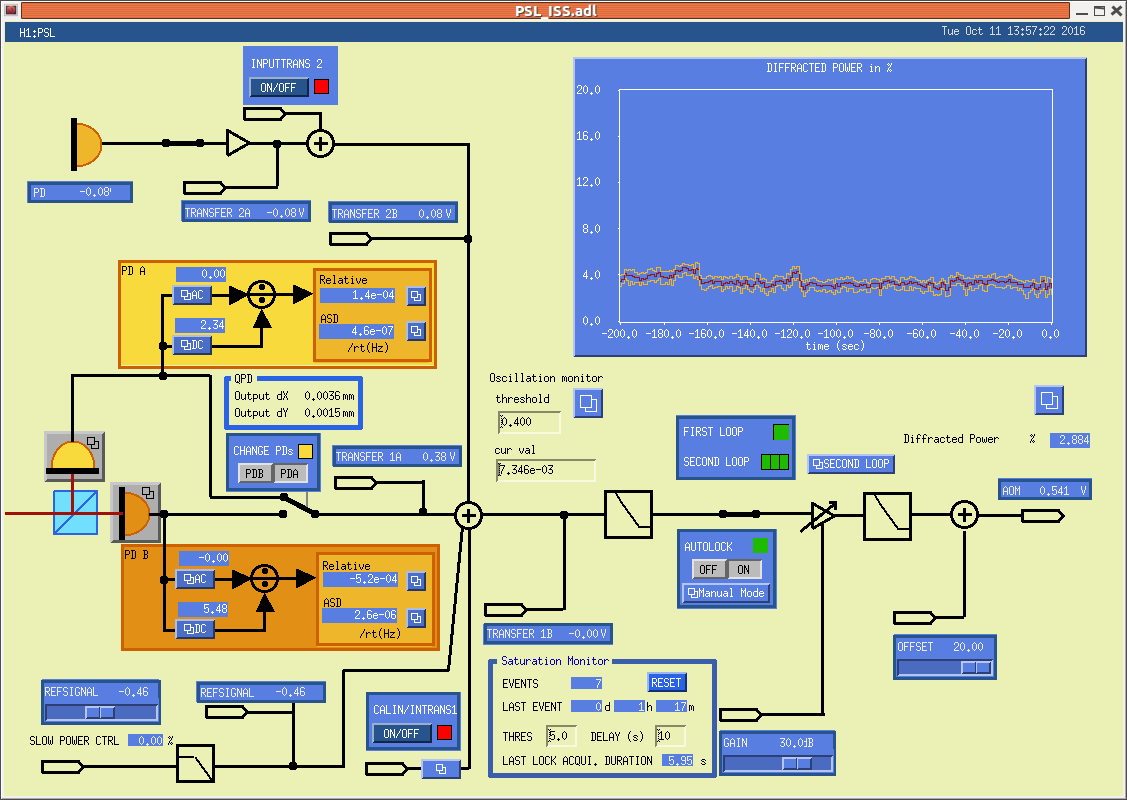J. Kissel I've used Kiwamu's templates (LHO aLOG 29860) to gather new DARM OLG and PCAL2DARM transfer functions, to help increase the number of data points for darm coupled cavity pole and SRC detuning spring frequencies. In doing so, I've found that PCAL suggests that CAL-DELTAL_EXTERNAL is wrong low by ~20% above 50 Hz, in a frequency dependent fashion (confirmed by the phase and ridiculously high coherence). We will analyze the data in-full, and report what the measured pole and spring frequencies are in the morning. We'll also show trends of calibration line heights, such that eventually we can confirm the frequencies over time. This frequency dependent error in CAL-DELTAL_EXTERNAL may be because the DARM coupled cavity pole frequency programmed into the CAL CS fron end is 342 Hz, and that's just not correct for this lock stretch. We have to turn OFF the PCALY calibration lines during the measurement due to range issues, but the front end calculation of the DARM cavity pole, after the measurement, suggests anywhere for 315 Hz to 340 Hz. Unclear whether we can trust the online calculation just yet, so we're leaving the IFO alone for ~30 minutes after the measurement to be able to confirm offline later. Recall that we're still not controlling the cavity waist angle/translation of the SRC entirely: the SRC1 loop (nominally controlling SRM alone) is OFF, but the SRC2 loop (controlling SRM and SR2) is ON. Undisturbed time post-sweeps: Start Oct 11 2016 02:36:00 UTC Oct 10 2016 19:36:00 PDT 1160188577 Stop Oct 11 2016 03:07:00 UTC Oct 10 2016 20:07:00 PDT 1160190437 The new measurements have not yet been exported, but have been committed to the CalSVN here: /ligo/svncommon/CalSVN/aligocalibration/trunk/Runs/PreER10/H1/Measurements/ DARMOLGTFs/2016-10-10_H1_DARM_OLGTF_4to1200Hz.xml PCAL/2016-10-10_H1_PCAL2DARMTF_4to1200Hz.xml EDIT: I've added two screenshots showing the digital settings relevant to the DARM loop parameters. Unfortunately, the production conlog is down for maintenance/upgrades, but thankfully Patrick setup a test bed a few nights ago (goto http://conlog-test-replica/), I was able to pull the list of channels I needed. FAlso for the record, some of those channels have changed since O1, so I quote the new list here for easier copy and paste in the future: H1:LSC-DARM1_SWSTAT H1:LSC-DARM1_GAIN H1:LSC-DARM2_SWSTAT H1:LSC-DARM2_GAIN H1:SUS-ETMY_L1_LOCK_L_SWSTAT H1:SUS-ETMY_L1_LOCK_L_GAIN H1:SUS-ETMY_L1_DRIVEALIGN_L2L_SWSTAT H1:SUS-ETMY_L1_DRIVEALIGN_L2L_GAIN H1:SUS-ETMY_L2_LOCK_L_SWSTAT H1:SUS-ETMY_L2_LOCK_L_GAIN H1:SUS-ETMY_L2_DRIVEALIGN_L2L_SWSTAT H1:SUS-ETMY_L2_DRIVEALIGN_L2L_GAIN H1:SUS-ETMY_L3_ISCINF_L_SWSTAT H1:SUS-ETMY_L3_ISCINF_L_GAIN H1:SUS-ETMY_L3_LOCK_L_SWSTAT H1:SUS-ETMY_L3_LOCK_L_GAIN H1:SUS-ETMY_L3_DRIVEALIGN_L2L_SWSTAT H1:SUS-ETMY_L3_DRIVEALIGN_L2L_GAIN H1:SUS-ETMY_L3_LOCK_INBIAS H1:SUS-ETMY_L3_ESDOUTF_LIN_BYPASS_SW H1:SUS-ETMY_L3_ESDOUTF_LIN_FORCE_COEFF H1:SUS-ETMY_BIO_M0_STATEREQ H1:SUS-ETMY_BIO_L1_STATEREQ H1:SUS-ETMY_BIO_L2_UL_STATEREQ H1:SUS-ETMY_BIO_L2_LL_STATEREQ H1:SUS-ETMY_BIO_L2_UR_STATEREQ H1:SUS-ETMY_BIO_L2_LR_STATEREQ H1:SUS-ETMY_BIO_L3_UL_STATEREQ H1:SUS-ETMY_BIO_L3_UR_STATEREQ H1:SUS-ETMY_BIO_L3_LL_STATEREQ H1:SUS-ETMY_BIO_L3_LR_STATEREQ
J. Kissel, D. Tuyenbayev,
Kappas calculated in the front-end suggest that an optical gain was lower compared to the reference time (optical gain in the DARM model) by ~15% and the coupled-cavity pole frequency was ~325 Hz at the TF measurement time.
Also it seems that the SNR of 331.9 Hz line is not sufficient - higher statistical noise in the calculated κC and fC.
A little bit more quantitative assessment if the time dependent correction factors as computed by the front end (or "kappas"):
I've grabbed similar undisturbed data from the times quoted in the original entry, and replotted them in matlab after doing some rudimentary math. The 15 minute (900 sec) average value (starting at Oct 11 2016 02:51:00 UTC) for all of the time dependent parameters just after the sweeps are:
Param Units Mean Std
kappa_{C} [ ] 0.866 pm 0.011
f_{cc} [Hz] 323 pm 4.5
Re: kappa_{PU} [ ] 1.01 pm 0.011
Im: kappa_{PU} [ ] -0.007 pm 0.012
Re: kappa_{TST} [ ] 0.998 pm 0.0085
Im: kappa_{TST} [ ] 0.0095 pm 0.0065
Input Power [W] 50.5 pm 0.031
The script to generate these values lives in
/ligo/svncommon/CalSVN/aligocalibration/trunk/Runs/PreER10/H1/Scripts/CAL_EPICS/get_fe_tdep_params.m
And for ease of copy and paste for someone in the future, I'm gathering the following channels (which correspond to the parameters in the same order as the table above)
H1:CAL-CS_TDEP_KAPPA_C_OUTPUT
H1:CAL-CS_TDEP_F_C_OUTPUT
H1:CAL-CS_TDEP_KAPPA_PU_REAL_OUTPUT
H1:CAL-CS_TDEP_KAPPA_PU_IMAG_OUTPUT
H1:CAL-CS_TDEP_KAPPA_TST_REAL_OUTPUT
H1:CAL-CS_TDEP_KAPPA_TST_IMAG_OUTPUT
H1:IMC-PWR_IN_OUTPUT







































